Related Research Articles

Rockabilly is the earliest style of rock and roll music. It dates back to the early 1950s in the United States, especially the South. As a genre it blends the sound of Western musical styles such as country with that of rhythm and blues, leading to what is considered "classic" rock and roll. Some have also described it as a blend of bluegrass with rock and roll. The term "rockabilly" itself is a portmanteau of "rock" and "hillbilly", the latter a reference to the country music that contributed strongly to the style. Other important influences on rockabilly include western swing, boogie-woogie, jump blues, and electric blues.

"Shake, Rattle and Roll" is a song, written in 1954 by Jesse Stone. The original recording by Big Joe Turner is ranked number 127 on the Rolling Stone magazine's list of The 500 Greatest Songs of All Time.

"A Little Less Conversation" is a 1968 song recorded by American singer Elvis Presley, written by Mac Davis and Billy Strange and published by Gladys Music, Inc., originally performed in the film Live a Little, Love a Little. The song became a minor hit in the United States when released as a single with "Almost in Love" as the A-side. A 2002 remix by Dutch musician Junkie XL of a later re-recording of the song by Presley became a worldwide hit, topping the singles charts in nine countries and was awarded certifications in ten countries by 2003.

"All Shook Up" is a song recorded by Elvis Presley, published by Elvis Presley Music, and composed by Otis Blackwell. The single topped the U.S. Billboard Top 100 on April 13, 1957, staying there for eight weeks. It also topped the Billboard R&B chart for four weeks, becoming Presley's second single to do so, and peaked at No. 1 on the country chart as well. It is certified 2× platinum by the Recording Industry Association of America.

"Jailhouse Rock" is a song recorded by American singer Elvis Presley for the film of the same name. It was written by Jerry Leiber and Mike Stoller. RCA Victor released the song on a 45 rpm single on September 24, 1957, as the first single from the film's soundtrack EP. It reached the top of the charts in the U.S. and the top 10 in several other countries. The song has been recognized by the Grammy Hall of Fame, the American Film Institute, and others.
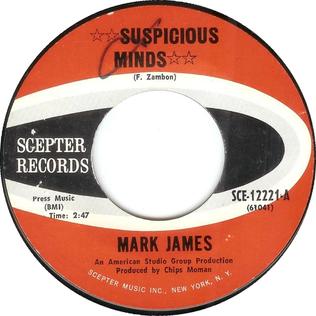
"Suspicious Minds" is a 1968 song written and first recorded by the American songwriter Mark James. After this recording failed commercially, it was recorded by Elvis Presley with the producer Chips Moman. Presley's version reached No.1 on the US Billboard Hot 100.
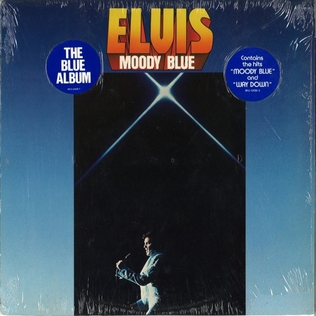
Moody Blue is the twenty-fourth and final studio album by American singer and musician Elvis Presley, released on July 19, 1977 by RCA Records, four weeks before his death. The album was a mixture of live and studio work, and included the four tracks from Presley's final studio recording sessions in October 1976 and two tracks left over from the previous Graceland session in February 1976. "Moody Blue" was a previously published hit song recorded at the earlier Graceland session and held over for this album. Also recorded at the February session was "She Thinks I Still Care". "Way Down" became a hit after Presley's death less than one month after this album's release. The album was certified Gold and Platinum on September 12, 1977, and 2× Platinum on March 27, 1992, by the RIAA.
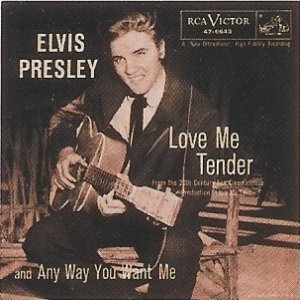
"Love Me Tender" is a 1956 ballad song recorded by Elvis Presley and published by "Elvis Presley Music" from the 20th Century Fox film of the same name. Lyrics are credited to "Vera Matson" and Elvis Presley himself. The melody is identical to the sentimental Civil War ballad "Aura Lea" and therefore credited to Aura Lea's composer, the Englishman George R. Poulton. The RCA Victor recording by Elvis Presley was No. 1 on both the Billboard and Cashbox charts in 1956.
"Don't Be Cruel" is a song that was recorded by Elvis Presley and written by Otis Blackwell in 1956. It was inducted into the Grammy Hall of Fame in 2002. In 2004, it was listed #197 in Rolling Stone's list of 500 Greatest Songs of All Time. The song is currently ranked as the 173rd greatest song of all time, as well as the sixth best song of 1956, by Acclaimed Music.

"In the Ghetto" is a 1969 song recorded by Elvis Presley and written by Mac Davis. It was a major hit released in 1969 as a part of Presley's comeback album, and also on the single release of "Any Day Now" as the flip side.

Carl Stuart Hamblen was an American entertainer who became one of radio's first singing cowboys in 1926, going on to become a singer, actor, radio show host, and songwriter. He underwent a Christian conversion and became a Temperance movement supporter and recurring candidate for political office. He is best known as the composer of the song "This Ole House" (1954), most notably recorded by Rosemary Clooney and Shakin' Stevens.

"Are You Lonesome Tonight?" is a song written by Roy Turk and Lou Handman in 1926. It was recorded several times in 1927—first by Charles Hart, with successful versions by Vaughn De Leath, Henry Burr, and the duet of Jerry Macy and John Ryan. In 1950 the Blue Barron Orchestra version reached the top twenty on the Billboard's Pop Singles chart.

"Tell Me Why" is a popular song, written by Titus Turner in 1956. It is a slow, strong rhythm and blues ballad, and has a melody reminiscent of "Just a Closer Walk With Thee".
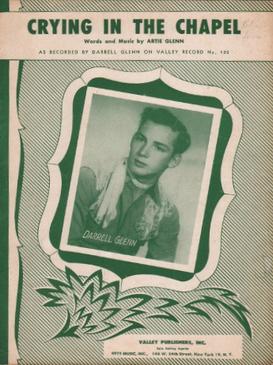
"Crying in the Chapel" is a song written by Artie Glenn and recorded by his son Darrell Glenn. The song was released in 1953 and reached number six on the Billboard chart.
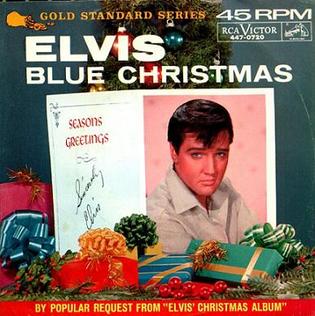
"Blue Christmas" is a Christmas song written by Billy Hayes and Jay W. Johnson and most famously performed by Elvis Presley; it was first recorded by Doye O'Dell in 1948. It is a tale of unrequited love during the holidays and is a longstanding staple of Christmas music, especially in the country genre.
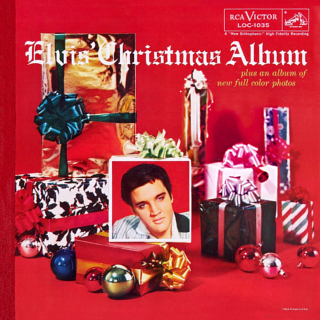
Elvis' Christmas Album is the third studio album and first Christmas album by American singer and musician Elvis Presley on RCA Victor, LOC -1035, a deluxe limited edition, released October 15, 1957, and recorded at Radio Recorders in Hollywood. It has been reissued in numerous different formats since its first release. It spent four weeks at No. 1 on the Billboard Top Pop Albums chart, and was the first of two Christmas-themed albums Presley would record, the other being Elvis Sings the Wonderful World of Christmas, released in 1971. The publication Music Vendor listed Elvis' Christmas Album on their singles charts for two weeks in December 1957 – January 1958, with a peak position of No. 49.

From Elvis Presley Boulevard, Memphis, Tennessee is the twenty-third studio album by American singer and musician Elvis Presley, released by RCA Records in May, 1976. It became Presley's fourth album to reach #1 on the Billboard country music album sales chart within the last four years.
"(Now and Then There's) A Fool Such as I" is a popular song written by Bill Trader and was published in 1952. Recorded as a single by Hank Snow it peaked at number four on the US country charts early in 1953.

"I Forgot to Remember to Forget" is a 1955 rockabilly and country song, first recorded by Elvis Presley written by Stan Kesler and Charlie Feathers. It was Elvis' first no. 1 record nationally. The single was the fifth and final single released on Sun Records before Elvis moved to RCA Records.
The albums discography of Elvis Presley began in 1956 with the release of his self-titled debut album, Elvis Presley.
References
- ↑ "ASCAP". Ascap.com. Retrieved 2 May 2021.[ permanent dead link ]
- 1 2 Joel Whitburn (1996). The Billboard Book of Top 40 Country Hits. Billboard Books. p. 139. ISBN 0823076326.
- ↑ "The Year's Top Country & Western Records" (PDF). The Billboard. January 13, 1951. p. 19. Retrieved November 30, 2020.[ dead link ]
- ↑ "Stuart Hamblen". Archived from the original on 2013-05-11. Retrieved 2020-12-02.
- 1 2 "Elvis Presley - Studio Recording Sessions". 28 November 2006. Archived from the original on 2006-11-28. Retrieved 2 May 2021.
- ↑ "Elvis Discography 1957". Sergent.com.au. Retrieved 2 May 2021.